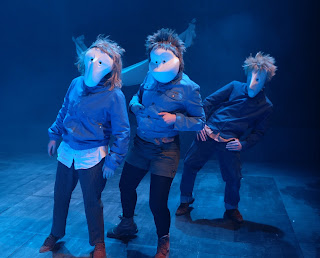Right from the start, Have I No Mouth is an disquieting show to watch. A smooth-talking humanist psychotherapist leads the Lyric Theatre audience through a mindfulness exercise to ensure we’re relaxed.
If that isn’t enough to raise your blood pressure, the show is based around a series of conversations between a mother and her son about the death of her husband as well as the death of her baby many years before. With an over-polite therapist gently guiding the discussion with injections that begin “I wonder if it would be helpful if you shared what …”
While many parts of the 70 minute show are fixed, there is room in the chat for mother and son to go off script and genuinely explore their grief through discussion of objects that symbolise intimate moments in their family life.
“Will I tell you? / No. / Well I’m going to …”
Mother and son bicker. She answers questions the therapist intends for her son. She asks her son questions and then answers them before he can. Gently we watch two people reveal what they are afraid of and tussle with different attitudes to sentimentality. We feel the tension as they outline competing and contradictory memories of the same event.
It nearly feels inappropriate to name the performers, given that they are real people revealing their feelings and the inner workings of their family in front of a therapist. But this is a stage show from Brokentalkers (in association with Project Arts Centre) that won an award at the Edinburgh Festival and is now on its second national tour.
Feidlim Cannon
Erich initially sits to one side of the stage and runs out of dialogue about half way through the show. That’s not to say that his role in the therapy is over; instead he becomes much more intimately involved in Ann and Fiedlam’s memories as flashbacks bring to life painful moments from the family’s past.
There’s a lot going on in the show: a tribute video, balloons, a child’s game, and some unexpected camera work. It also added another new way of making it snow in the Lyric’s Naughton Studio theatre to my ever expanding list.
I can’t say that Have I No Mouth was a pleasurable trip to the theatre. What starts out as a therapy session turns into an explosion of a son’s pent up anger and emotion. The ending is a mix of humiliation and catharsis, quite upsetting to watch, and a far cry from the show’s new age beginning.
It’s an unusual piece of theatre, but it’s not brave or dangerous. The performers are close relatives and are in good relationship, even if Ann doesn’t like to hear Feidlim swear. A lot of time has passed and the grief is not as raw as it once might have been. Everything is under control.
The concept reminds me of Jo Berry’s series of public conversations with Patrick Magee, the ‘Brighton Bomber’ who murdered her father. Their conversations have quite an edge to them. Blood has been shed rather than shared. (You can listen back to one from June 2015 when they were joined by Ann Travers up at the Xchange Summer School in Derry.)
Instead Have I No Mouth is an uncomfortable insight – perhaps an intrusion – into one family’s grief. Uncomfortable because at times we’re laughing out loud at someone else’s misery, including the death of an infant (in front of his mother) and the medical misdiagnosis that prematurely ended the life of a husband and father.
Have I No Mouth continues its Irish tour with performances scheduled in Cork, Dublin and Bray in early May.























